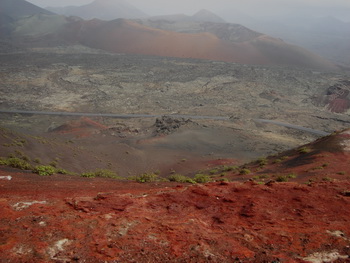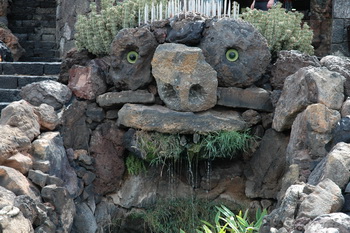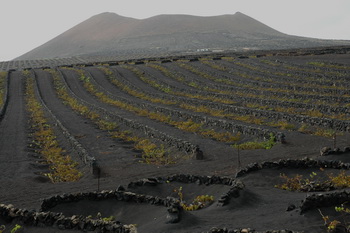
Lanzarote
Touring the Island
October 2008
Part Four
| |
| HOME |
| About Tenaya |
| About Us |
| Latest Update |
| Logs from Current Year |
| Logs from Previous Years |
| Katie's View |
| Route Map |
| Links |
| Contact Us |
![]()
October 23 , 2008
Lanzarote is a fascinating island. At first glance the landscape looks a bit like pictures taken of the surface of the moon with square white buildings spread about, but in no time the natural beauty makes itself apparent.

The striking landscape of the Mountains of Fire

One of the many volcanic craters in Timanfaya National Park
The first place we visited with our rental car was Timanfaya National Park. It really has the appearance of a lunar landscape! The land in the south western part of the island had been fertile and cultivated until 1730 when the earth erupted. Eruptions continued for six years. Not just one volcano, but many, blew. More than twenty villages were buried. The brutal forces of nature formed an incredible, stark, striking landscape, the Montanas del Fuego (Mountains of Fire).

The largest crater in the park is in the background

The road passes through interesting lava forms
For accessibility and to control man's impact on the land the park offers a bus tour along a 14 km. route. Passengers are not allowed to disembark but the driver stops several times to allow photos to be taken from inside the bus.

Dried brush burst into flames when placed one meter down this vent

Chicken served at the restaurant in the park is grilled over a fumerole

It is possible to explore by riding a camel

Off go two groups of visitors on camels

El Golfo, the green lake separated from the sea by black sand

Los Hervideros at the sea and volcanos inland

Katie having a look around Los Hervideros

Lava flowed into the sea at Los Hervideros
Artist Cesar Manrique was born on Lanzarote in 1919, studied art in Madrid, lived in Paris in the early 50s and in NYC in the 60s. He returned to the island for good in 1966. Lanzarote's tourism industry was in the early stages and he promoted sustainable development to protect the natural and cultural heritage of the island. It was hugely successful and Lanzarote escaped the trappings of tourist development that has ruined other Spainish coastal resorts. Lanzarote was declared a UNESCO World Biosphere Reserve in 1993.

Typical building on Lanzarote. Manrique's influence lead to all the buildings having a harmonious look and feel.

The lagoon in Arrecife, capital of Lanzarote

Jim stands by our rental car, one of many that are nearly identical in style and size. They are much cuter than rental cars in the US!
.
The Fundacion Cesar Manrique is located in what had been Mr. Manrique's home. A fascinating structure, it appears from the street as a traditional house with a beautiful garden. Once inside visitors are treated to works by Manrique as well as other notable Spanish artists including Miro and Picasso. Each room of the main floor is bathed in natural sunlight entering large windows creating a bright and airy atmosphere. The building is constructed over a lava flow incorporating the rock into the architecture. The rooms on the lowest level use the natural formation of five volcanic bubbles, which are all open to the sky or main floor, and are connected to each other by halls bored into the basalt. In one room the rock seen outside the ceiling-to-floor windows of the main floor continues into the house creating a feeling of being both inside and outside at the same time. His extensive use of smooth white surfaces contrast beautifully with the irratic, dark volcanic rock. It is an incredible example of architecture in harmony with nature.

A colorful mural by Manrique decorates the wall of the garden

The bubble in the center of the lower level has a delightful pool, fountain, grill and several seating areas

An entertaining room in one of the bubbles

Volcanic bubbles are connected by tunnels bored in the basalt.

The volcanic rock flows into the building separated only by glass
El Mirador del Rio sits 480 meters above sea level at the northern tip of the island. An old military artillery position, Cesar Manrique converted it into a viewpoint where the spectacular landscapes of Lanzarote as well as the islands to the north can be enjoyed.

Entry into the restaurant and lower viewing area

Staircase in typical Manrique style leads to the upper outside viewing area

View of Isla Grasiosa from El Mirador del Rio
El Jardin de Cactus was the final project Manrique accomplished before his death. It is built in an old rofero. A rofero is the large hole left after farmers have dug out volcanic ash to cover their harvesting fields. Hand cut blocks of basalt line the rofero and create a huge amphitheater containing volcanic stone terraces and walkways showcasing 1420 different species of cacti.




We both liked this fountain with a face in the Jardin de Cactus
Amazingly, people cultivate crops in this arid climate. Low walls are built of volcanic rock to protect the plants and volcanic ash is spread over the ground to trap and contain dew which is formed by the trade winds. Delicious wine is produced here.

Vineyards in the center of the island

Cacti are raised and cochineal, a beetle that lives on the stems of the cacti, is harvested to produce a red dye used for cosmetics and food processing.
Happy Birthday Scott!
.